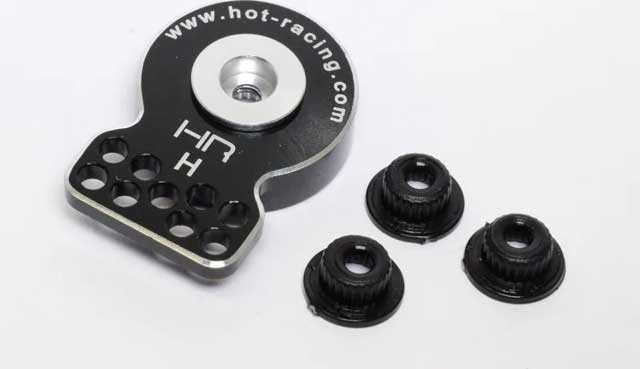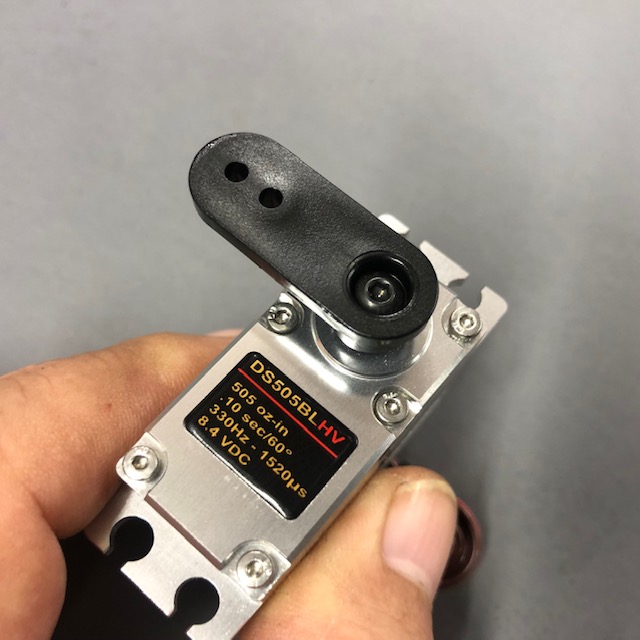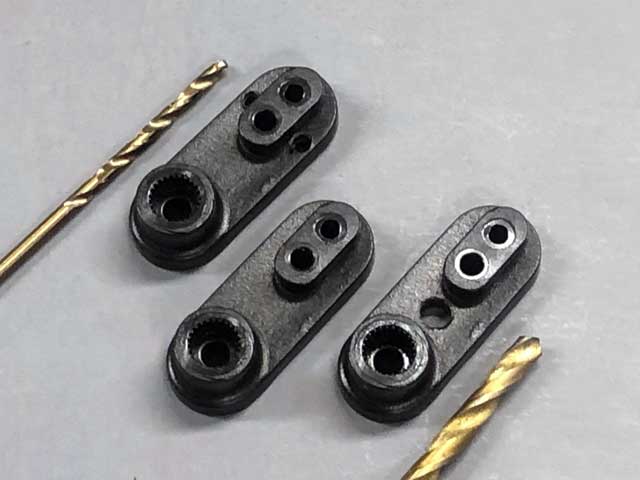Made of heavy duty plastic (technically a fiber-filler engineering polymer like is found in 9mm handgun frames), this super tough servo horn is ideal for use in steering mechanism of RC trucks - suitable for servos up to 630oz-in.
Dimensions: ø6mm, 25-spline (Futaba-compatible)
- 1st bore: 15mm
- 2nd bore: 20mm
Note; you have to decide on quantity before you add them to
your shopping cart, so if you select quantity 5, and then within the
shopping cart notice it only says qty 1 and change it there to quantity
5, then what you'll get will five packs of qty 5 . . . heads up!
Nothing is unbreakable. Least of all a servo - ours or anybody's. Yet we see guys attempting to create an unbreakable truck by replacing plastic components with aluminum ones - and the first part they replace is usually the servo arm (and we offer them too because we figure if you're going to buy one anyway, you may as well get our best effort). Thing is, we don't use the aluminum servo arm ourselves - our advice is to ditch it in favor of these heavy duty plastic ones.
The concept behind the design is similar to that of a fuse. Just like a fuse blows with too much current and saves the circuit, this servo arm hopefully breaks to save more expensive stuff. So think of it as a mechanical fuse!
Is it a pain in the ass having to stop and replace the stupid plastic arm when it breaks? Yes, it is. Fortunately, it only takes a moment and you can bet it saved something else from breaking. Something harder to repair/replace (and more costly, too).
Last thing; you have to select quantity before adding to cart, e.g. select qty 1, 5, or 25. And note; everybody starts with a bag of 5 and almost everybody reorders bags of 25. Anyway, yes they break - they're supposed to! Yes, you'll go through them like candy if you're hard on your equipment. And yes, this is aggravating compared to an aluminum arm. It's the nature of the beast, but for those who figure it's better than sacrificing a servo or some pricey steering component, you're who we make the for!
During an online conversation on www.arrmaforum.com I noticed where the
purpose/function/benefit of the servo-saver may be misunderstood by
someone following along; specifically, where it's said about a servo saver;
I’ve
got 4 clips in mine and I still see it flexing when turning the wheels
when stationary on carpet so my extra torque just went to the servo
spring.
. . . and while this is 100%
accurate, the point of the device is precisely that, to save the servo,
and thus, the movement being discerned isn't 'wasted' per se, it's there
to serve a function.
Note how he takes care to note he's using 4 clips. But if all you get from that is 4
is more tight than 3 you risk overlooking the importance of where he
said, 'torque just went to the servo spring'.
This
is because he astutely acknowledges the servo is actually steering the
spring, and it's the spring that steers the rig 'until' it hits the
mechanical limits of the of the device. So
basically, when it hits mechanical limits is when the saver transitions
from saver-function to direct mechanical action. This is an important distinction.
Note;
the spring is the mechanical equivalent of putting a rubber doughnut
within an arm to absorb minor shocks, but instead of having 4-different
durometers of rubber (meaning four different arms) it has a spring whose
force is adjustable with clips. But whether rubber or spring, the idea
of this type of mechanism is to soften the hit. But the hit's still
coming no matter what.
So
why four clips instead of three? First, the obvious function to tighten
it up. To put torque to the spring more firmly - with greater authority.
But bear in mind, the tighter you go (the more clips), the less it
works as a 'saver' for your servo. How tight is too tight? When you tear
up your servo!
Tearing up
your servo is when transient inputs aren't sufficiently transient to be
damped by the mechanism. Thing is, finding the sweet spot can be tricky.
Too few clips leaves you with a feel that's vague. Go beyond vague and
it's downright wishy-washy. But go too far the other way and the feel is
more positive but now there's greater risk that you tear up servos.
Fortunately, you're not locked into the stock adjustable servo saver.
What are alternatives?
While
some folk's first instinct is to opt for a different saver from the
factory solution. Maybe a nice aftermarket unit like the 88S from the
likes of Hot Racing is suitable . . .

. . . suitable being defined as easier to find the sweet spot between too soft for precision steering and too hard.
But there's yet another way. The fusible link concept. The arm in
the photo below is of something designed to mechanically fail - but -
not be wishy-washy in any way whatsoever in the meantime.

Being made of polymer means it can break. But until it breaks, it's got the tight mechanical feel of an alloy arm,
meaning no 'give' to speak of. And under a hard impact it fails, the polymer horn
breaks. By definition, this means it too is a servo saver. The major point however, is it's 'just' strong enough to not forever be replacing them.
So
what's important about all of this is . . . impacts aren't just the
pile driver than breaks the servo regardless of the saver being there or
not, but also protects against glancing blows. You grok kissing a post
is still the same post but not hitting it squarely? The
saver is there for the glancing blows, not for dead hits. Saver itself
also fails on dead hits, as will the above horn, but what the horn gives
you is a different way of failing. The principal advantage is no vague-feeling.
So as the saying goes, there's
more than one way to skin the cat. My point is there's an alternative to
a traditional servo saver that doesn't involve sacrificing all protection. I term it a mechanical fuse. We produce a servo horn
that's beefy and designed to let you steer without losing any of the
torque you've paid for - until - you lose it all because it broke. And it's a strong horn. Sometimes too strong. Point being, you also can mod it to be strong. Finally we get to the point (and hopefully an aha-moment).
Recapping
before proceeding, just like a fuse is designed to burn up and save the
wiring in the wall, the mechanical fuse concept is one where something
cheap and easy to replace (a special control horn) fails without
destroying a servo - or - expensive steering components.It's our part number PDRS105.
But did you know you can mod this arm and make it fail sooner? Why?
How?
Simple, with a drill. Why is practically self-explanatory, e.g.when you
want less than factory force to break it (it fails around 600oz-in). So sometimes it's worth fooling around with intentionally weakening it, so it breaks at 400oz-in. But while this is not exact, it's surprisingly repeatable meaning you can fool around with hole size diameters and repeatably fail where it best suits you.
This leads to the how, which is
to drill some holes in it of whatever size and location suits you
because one, or two, or three holes of varying sizes can weaken it
further. This means you can actually tailor where it fails! Crude,
rudimentary? Yes, but repeatable . . . adjustable. The point is to play around and try drilling holes to weaken it to find exactly where you prefer it to fail . . . and save the expensive bits of your rig.

Bottom line? Some positively dislike any play in their saver, so they are running a lot of clips to
minimize it, but you also don't want the risk of an alloy arm, so now you've learned of an alternative. Run the stock PDRS105, a beefy polymer horn designed
to be 'just' strong enough it doesn't fails with any little thing. Or tailor where it fails with a bit of
creating modding through using a drill bit.So if you hate the thought of even a little bit of the torque going to
the spring, then using a servo horn designed to fail - functioning as a
mechanical fuse - is the next best thing.
Anyway,
these are offered in qty 1, 5, 25. We mostly see
folks buy one, or a bag of 5 the first time. But next time, they often get
bags of 25. (maybe they're experimenting a lot, or a group buy, or to
sell trail side - dunno). However,
remember, the fundamental idea of this horn is to be happy when you replace one. Throw a party! Why? Simple,
it's because it probably saved you the time and money of a real repair,
e.g. sending in a servo to be re-geared, or replacing expensive
steering/suspension components.